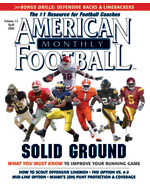AMERICAN FOOTBALL MONTHLY THE #1 RESOURCE FOR FOOTBALL COACHES
Article CategoriesAFM Magazine
|
Looking For a Boost in Your Offense?Bucknell University uses the Mid-Line Option to get the ball in the hands of their playmakers and to add some punch to their offense.by: Tim Camp Offensive Coordinator/Offensive Line Coach by: Brent Thompson Quarterbacks/Fullbacks Coach, Bucknell University © More from this issue Why Mid-Line? Our first season at Bucknell we had installed a spread option offense. We invested a lot of time into our base play: the triple option. As the season progressed we had been able to execute the triple with some moderate success. At the end of the 2003 season we had averaged just a little over six yards per attempt. We had run some mid-line in 2003 but were not majoring in it. We, as an offensive staff, knew that in order for us to compete on a yearly basis with the teams in the Patriot League we would have to develop a multi-faceted option attack. We needed a play that looked similar to triple option but allowed us to get downhill faster and provide us with some options as to what we can do with the football. The mid-line forced teams to defend both the mid-line option and the triple option. It pr....The full article can only be seen by subscribers. Subscribe today!
|
|
|||||||
| HOME |
MAGAZINE |
SUBSCRIBE | ONLINE COLUMNISTS | COACHING VIDEOS |
Copyright 2025, AmericanFootballMonthly.com
All Rights Reserved





